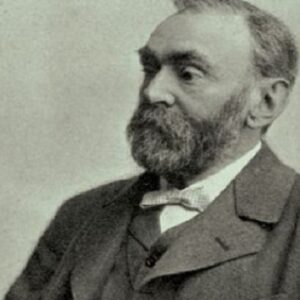Alfred Bernhard Nobel was a Swedish inventor, engineer, and businessman who held 355 patents during his lifetime. He was well known for inventing dynamite and producing more powerful explosives as well as detonators to light them. He gained a vast wealth from his businesses, which included a network of nearly a hundred factories around the world that manufactured explosives and ammunition. He was, in fact, one of the world’s wealthiest people at the time of his death. There were many rumors concerning the contents of his last will, which he signed on November 27, 1895, because he was unmarried and childless. The contents of Nobel’s will disappointed his highly-anticipated extended family, since he had given much of his fortune to establish an international award fund! Nobel, a pacifist at heart, was severely scarred by the moniker ‘The Merchant of Death’ he had earned as the inventor of dynamite. He did not want to be known as the architect of mass destruction after his death, so he gave a large portion of his fortune to establish the Nobel Prizes, which will be granted for brilliance in five categories without regard to nationality.
Childhood and Adolescence
He was one of Immanuel Nobel and Karolina Andriette’s eight children. Only Alfred and three of his siblings grew up, while the rest of the children died. His father worked as an engineer and inventor.
After years of trying unsuccessfully to start a business, his father was finally successful in creating a machine tool and explosives manufacturing company.
Alfred was educated by private tutors, and he excelled in his academics. He was particularly interested in science and languages, speaking English, German, French, and Russian fluently.
In 1850, he moved to Paris to study under chemist Nikolai Zinin. He was so passionate about chemistry that he moved to the United States at the age of 18 to complete his education in the field. In 1857, he applied for his first patent, which was for a gas meter.
A Years Later
After finishing his studies, he went to work in his father’s factory. In 1859, his brother Ludvig took over the plant, which prospered under his leadership. Alfred was fascinated by explosives and experimented constantly with nitroglycerine, a highly explosive substance.
Five individuals, including his younger brother Emil, were killed in a horrific accident at the shed where nitroglycerin was prepared. Nobel began to concentrate more on producing explosives that were less dangerous than nitroglycerin.
He discovered that when nitroglycerin was coupled with an absorbent inert substance, it became more convenient to handle and safer to use through repeated experimentation.
Dynamite, a novel material, was developed in 1867 and has since been widely used in mining around the world. It was the first explosive that could be properly handled and was more powerful than black powder.
He combined nitroglycerin with nitrocellulose chemicals to create a transparent, jelly-like fluid that was much more powerful than dynamite, continuing his obsession with the substance.
Gelignite was the name given to it, and it was patented in 1876. Gelignite was more stable and more suitable for mining. This discovery enabled him to collect a large sum of money.
His brothers became successful and affluent businessmen by utilizing the Caspian Sea’s oilfields. Nobel also made a lot of money by investing in their company.
He developed a smokeless propellant containing 10% camphor and produced from nitrocellulose and nitroglycerin. Ballistite was the name given to this mixture, which was patented in 1887.
Ludvig, his brother, died in Cannes in 1888. A French newspaper mistook him for his more famous brother and published his obituary, incorrectly declaring that “the merchant of death is dead.” Alfred was devastated to learn that this would be how he would be remembered when he died.
He wanted to make amends for his bad image, so he set aside a large portion of his vast fortune to establish an international award fund to honor famous figures in the disciplines of physics, chemistry, medicine, literature, and peace work.
His last will and testament, dated November 27, 1895, provided the groundwork for the award. In 1901, the first Nobel Prizes were given out.
Alfred’s Major Projects
He invented dynamite, an explosive commonly employed in mining, quarrying, construction, and warfare. The creation of dynamite, which is made with nitroglycerin and other absorbent materials, is unstable and deadly. Gelignite and ballistite, two explosives he designed, were also created by him.
He created the groundwork for the Nobel Prizes by bequeathing a large portion of his fortune to establish an international award fund to recognize outstanding accomplishments in a variety of sectors of science and the arts.
Personal History and Legacy
He fell in love with Alexandra, a Russian girl who turned down his proposal. Later, he developed emotions for Bertha Kinsky, his secretary, with whom he had a close friendship until his death. In 1876, he met Sofie Hess and began a relationship with her that lasted 18 years.
He was a loner who suffered from depression and never married or had children.
He had a passion for reading since he was a child, and he used to create poetry. Because his parents were opposed to his writing endeavors, he was never able to have his work published.
He had spent his entire career working in close proximity to explosive substances, which had a significant impact on his health. In 1896, he died of a stroke.
Estimated Net worth
The majority of Alfred Nobel’s fortune, more than SEK 31 million (about SEK 1,702 million today), was left to be turned into a fund and invested in “secure securities.”
The profits from the investments were to be “given annually in the form of rewards to individuals who have conferred the greatest benefit over the prior year.”


